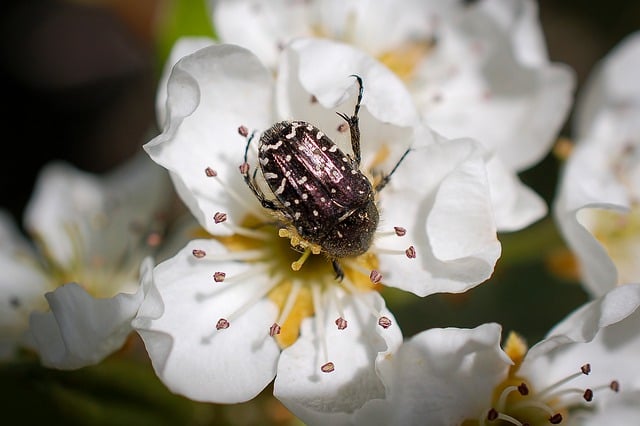Cigarette beetles, persistent pests in organic materials, are best controlled through eco-friendly methods. Homeowners can prevent infestations with good housekeeping, sealing entry points, and using natural repellents like cedarwood oil or essential oils. Traditional techniques include lavender, mint, citrus oils, diatomaceous earth, and specialized traps. Integrated Pest Management (IPM) combines biological controls, cultural practices, monitoring, physical removal, and mechanical trapping for a comprehensive, sustainable solution to cigarette beetle management, appealing to environmentally-conscious consumers seeking chemical-free alternatives.
In the realm of pest control, managing cigarette beetles requires a delicate balance between eliminating these pests and preserving the environment. This article explores humane and eco-conscious approaches to combat cigarette beetles, offering guidance for homeowners seeking effective yet sustainable solutions. We delve into understanding these insects’ behavior and habitat, providing traditional yet compassionate methods and introducing integrated pest management—a holistic approach to pest control for cigarette beetles.
Understanding Cigarette Beetles: Behavior and Habitat
Cigarette beetles, scientifically known as Lasioderma sericta, are small but tenacious insects that have become a significant pest in various environments, from homes to warehouses. Understanding their behavior and habitat is crucial for effective and eco-conscious pest control for cigarette beetles. These beetles are attracted to organic materials, especially cellulose, making them prevalent in areas with high levels of these substances like paper products, textiles, and wood. They are known for their ability to bore into and feed on a wide range of materials, causing substantial damage if left unchecked.
Cigarette beetles are nocturnal creatures that prefer cool, dark places during the day, hiding in cracks, crevices, and voids. Their intricate burrowing patterns can make them difficult to detect until they’ve already established a robust colony. To manage these pests humanely, it’s essential to adopt strategies that disrupt their natural behaviors without causing harm. This includes maintaining good housekeeping practices, sealing entry points, using trap systems designed with non-toxic baits, and employing biological control methods such as introducing natural predators or parasites.
Eco-Friendly Prevention Strategies for Homeowners
For homeowners dealing with cigarette beetles, implementing eco-friendly prevention strategies is a proactive approach to managing these pests naturally. One effective method is maintaining excellent hygiene and cleanliness within the home, especially in areas prone to beetle infestation, such as storage rooms, attics, and basements. Regularly vacuuming floors, dusting surfaces, and promptly addressing any food debris or spills can deter beetles from being attracted to your home. Sealing entry points like cracks, gaps in doors, and windows is another crucial step; these access points can be sealed with caulk or weatherstripping to prevent beetles from sneaking in.
Additionally, using natural repellents like cedarwood oil, lavender, or mint essential oils around entry points and storage areas can serve as a non-toxic alternative to conventional pest control for cigarette beetles. These scents are known to repel beetles naturally without causing any harm to humans or pets. Homeowners can infuse these repellents into sachets or spray them around problem areas, creating an inhospitable environment for cigarette beetles while promoting a healthier and more sustainable living space.
Traditional yet Humane Pest Control Methods
In the realm of pest control, particularly for stubborn and often hidden nuisances like cigarette beetles, there exists a spectrum of traditional yet humane methods that offer eco-conscious alternatives. These approaches prioritize safety not just for the affected premises but also for beneficial insects, pets, and the broader ecosystem. One such method is the use of natural repellents like lavender, mint, or citrus essential oils, which have been proven effective in deterring cigarette beetles without resorting to harsh chemicals.
Another traditional yet humane technique involves physical removal and exclusion. This includes meticulously sweeping and vacuuming affected areas, sealing entry points with fine mesh screens, and employing traps specifically designed for beetle control. Such methods not only eliminate existing beetles but also prevent their return, offering a long-term solution that is both gentle on the environment and cost-effective. For instance, diatomaceous earth, a natural mineral powder, can be scattered in hidden corners and crevices to disrupt and desiccate the exoskeletons of beetles, providing an organic and safe barrier against infestations.
Integrated Pest Management: A Holistic Approach
Integrated Pest Management (IPM) offers a humane and eco-conscious approach to controlling cigarette beetles, moving beyond traditional chemical pesticides. This holistic method involves a combination of strategies tailored to specific beetle habitats and life cycles. By understanding the insects’ behavior, we can implement targeted interventions that minimize harm to non-target species and the environment.
IPM for pest control includes biological control methods, such as introducing natural predators or parasites, along with cultural controls like proper storage practices and sanitation. Monitoring traps and pheromone lures help identify beetle presence and guide timely intervention. Physical removal and mechanical trapping are also effective, especially in confined spaces. These integrated tactics ensure a comprehensive and sustainable solution to cigarette beetle management, appealing to environmentally-conscious consumers seeking alternatives to harsh chemicals for pest control.
In addressing the challenge of cigarette beetle management, it’s clear that a balanced approach is key. By combining eco-friendly prevention strategies with humane, traditional methods and integrating holistic practices, homeowners can effectively mitigate these pests while minimizing environmental impact. Adopting these strategies not only protects homes but also contributes to a healthier ecosystem. For those seeking pest control for cigarette beetles, this multi-faceted approach offers the best path forward.
